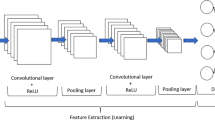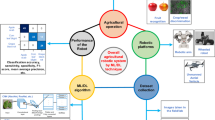Abstract
Sample collection is a fundamental issue in remote sensing image classification, active learning (AL) aims to solve the issue by guiding the sampling process to select the most informative samples. However, informativeness may not be enough due to it is inefficient to avoid redundant and low-representative pixels. To further improve AL performance, this work introduces a new diversity model based on the details of the classifier prediction. The probability values estimated by the classifier are used to reflect the differences between the unlabeled samples and those in the labeled training set. Through combining the proposed diversity and an existent informative metric, a new AL algorithm is developed. Such an approach is tested in a region of western Inner Mongolia. Two datasets are adopted. The experimental results validate the superiority of the proposed technique, and its average overall accuracy can reach 98.18% and 97.57% for the first and second dataset, respectively, when the number of the selected samples is between 300 and 345.














Similar content being viewed by others
Data availability
The bi-temporal image data set used in this study has been made freely available through the URL link: https://pan.baidu.com/s/1xtygVdKNm-zP44BFvUXIEQ (The extraction code is: ewua). The two images can be opened and visualized by using ENVI software.
References
Akar O, Güngör O (2015) Integrating multiple texture methods and NDVI to the random Forest classification algorithm to detect tea and hazelnut plantation areas in Northeast Turkey. Int J Remote Sens 36(2):442–464. https://doi.org/10.1080/01431161.2014.995276
Alajlan N, Pasolli E, Melgani F, Franzoso A (2014) Large-scale image Classifification using active learning. IEEE Geosci Remote Sens Lett 11(1):259–263. https://doi.org/10.1109/LGRS.2013.2255258
Amor IBSB, Chehata N, Bailly J, Farah IR, Lagacherie P (2018) Parcel-based active learning for large extent cultivated area mapping. IEEE J Sel Top Appl Earth Obs Remote Sens 11(1):79–88. https://doi.org/10.1109/JSTARS.2017.2751148
Belgiu M, Csillik O (2018) Sentinel-2 cropland mapping using pixel-based and object-based timeweighted dynamic time warping analysis. Remote Sens Environ 204:509–523. https://doi.org/10.1016/j.rse.2017.10.005
Belgiu M, Dragut L (2016) Random Forest in remote sensing: a review of applications and future directions. ISPRS J Photogramm Remote Sens 114:24–31. https://doi.org/10.1016/j.isprsjprs.2016.01.011
Bellón, B., A., Bégué, D., Seen, V., Lebourgeois, B. A. Evangelista, M. Simões, R. P. D. Ferraz. 2018. “Improved regional-scale Brazilian cropping systems’ mapping based on a semi-automatic object-based clustering approach.” Int J Appl Earth Obs Geoinf 68: 127–138. https://doi.org/10.1016/j.jag.2018.01.019.
Breiman L (2001) Random forests. Mach Learn 45:5–32. https://doi.org/10.1023/A:1010933404324
Duro DC, Franklin SE, Dubé MG (2012) A comparison of pixel-based and object-based image analysis with selected machine learning algorithms for the Classifification of agricultural landscapes using SPOT-5 HRG imagery. Remote Sens Environ 118:259–272. https://doi.org/10.1016/j.rse.2011.11.020
Geiß C, Thoma M, Pittore M, Wieland M, Dech SW, Taubenbock H (2017) Multitask active learning for characterization of built environments with multisensor earth observation data. IEEE J Sel Top Appl Earth Obs Remote Sens 10(12):5583–5597. https://doi.org/10.1109/JSTARS.2017.2748339
Geiß C, Thoma M, Taubenböck H (2018) Cost-sensitive multitask active learning for characterization of urban environments with remote sensing. IEEE Geosci Remote Sens Lett 15(6):922–926. https://doi.org/10.1109/LGRS.2018.2813436
Kim H, Yeom J (2014) Effect of red-edge and texture features for object-based Paddy Rice crop classification using Rapideye multi-spectral satellite image data. Int J Remote Sens 35(19):7046–7068. https://doi.org/10.1080/01431161.2014.965285
Li J, Bioucas-Dias JM, Plaza A (2011) Hyperspectral image segmentation using a new Bayesian approach with active learning. IEEE Trans Geosci Remote Sens 49(10):3947–3960. https://doi.org/10.1109/TGRS.2011.2128330
Li X, Chen W, Cheng X, Liao Y, Chen G (2017) Comparison and integration of feature reduction methods for land cover classification with RapidEye imagery. Multimed Tools Appl 76:23041–23057. https://doi.org/10.1007/s11042-016-4311-4
Luciano ACS, Picoli MCA, Rocha JV, Duft DG, Lamparelli RAC, Leal MGLV, Maire GL (2019) A generalized space-time OBIA classification scheme to map sugarcane areas at regional scale, using Landsat images time-series and the random forest algorithm. Int J Appl Earth Obs Geoinf 80:127–136. https://doi.org/10.1016/j.jag.2019.04.013
Ma L, Fu T, Li M (2018) Active learning for object-based image classification using predefined training objects. Int J Remote Sens 39(9):2746–2765. https://doi.org/10.1080/01431161.2018.1430398
Ma A, Chen D, Zhong Y, Zheng Z, Zhang L (2021) National-scale greenhouse mapping for high spatial resolution remote sensing imagery using a dense object dual-task deep learning framework: a case study of China. ISPRS J Photogramm Remote Sens 181:279–294. https://doi.org/10.1016/j.isprsjprs.2021.08.024
Niazmardi S, Homayouni S, Safari A (2019) A computationally efficient multi-domain active learning method for crop mapping using satellite image time-series. Int J Remote Sens 40(16):6383–6394. https://doi.org/10.1080/01431161.2019.1591648
Pasolli E, Melgani F, Tuia D, Pacififici F, Emery WJ (2014) SVM active learning approach for image Classifification using spatial information. IEEE Trans Geosci Remote Sens 52(4):2217–2233. https://doi.org/10.1109/TGRS.2013.2258676
Patra S, Bruzzone L (2012) A batch-mode active learning technique based on multiple uncertainty for SVM classifier. IEEE Geosci Remote Sens Lett 9(3):497–501. https://doi.org/10.1109/LGRS.2011.2172770
Samat A, Gamba P, Du P, Luo J (2015) Active extreme learning Machines for Quad-Polarimetric Sar Imagery Classifification. Int J Appl Earth Obs Geoinf 35:305–319. https://doi.org/10.1016/j.jag.2014.09.019
Setiyono TD, Quicho ED, Holecz FH, Khan NI, Romuga G, Maunahan A, Garcia C, Rala A, Raviz J, Collivignarelli F, Gatti L, Barbieri M, Phuong DM, Minh VQ, Vo QT, Intrman A, Rakwatin P, Sothy M, Veasna T, … Mabalay MRO (2019) Rice yield estimation using synthetic aperture radar (SAR) and the ORYZA crop growth model: development and application of the system in south and south-east Asian countries. Int J Remote Sens 40:8093–8124. https://doi.org/10.1080/01431161.2018.1547457
Stumpf A, Lachiche N, Malet J, Kerle N, Puissant A (2014) Active learning in the spatial domain for remote sensing image classification. IEEE Trans Geosci Remote Sens 52(5):2492–2507. https://doi.org/10.1109/TGRS.2013.2262052
Su T (2017) Efficient Paddy field mapping using Landsat-8 imagery and object-based image analysis based on advanced fractal net evolution approach. GIScience & Remote Sensing 54(3):354–380. https://doi.org/10.1080/15481603.2016.1273438
Su T, Zhang S, Liu T (2020) Multi-spectral image classification based on an object-based active learning approach. Remote Sens 12:504. https://doi.org/10.3390/rs12030504
Sun S, Zhong P, Xiao H, Wang R (2015) Active learning with Gaussian process Classififier for hyperspectral image Classifification. IEEE Trans Geosci Remote Sens 53(4):1746–1760. https://doi.org/10.1109/TGRS.2014.2347343
Wan S, Chang S (2018) Crop classification with WorldView-2 imagery using support vector machine comparing texture analysis approaches and Grey relational analysis in Jianan plain, Taiwan. Int J Remote Sens 40(21):8076–8092. https://doi.org/10.1080/01431161.2018.1539275
Wang Y, Guo YG, He J, Du LT (2016) Fusion of HJ1B and ALOS PALSAR data for land cover classification using machine learning methods. Int J Appl Earth Obs Geoinf 52:192–203. https://doi.org/10.1016/j.jag.2016.06.014
Wang X, Jia K, Liang S, Li Q, Wei X, Yao Y, Zhang X, Tu Y (2017a) Estimating fractional vegetation cover from Landsat-7 ETM+ Reflflectance data based on a coupled radiative transfer and crop growth model. IEEE Trans Geosci Remote Sens 55:857–865. https://doi.org/10.1109/TGRS.2017.2709803
Wang Z, Du B, Zhang L, Zhang L, Jia X (2017b) A novel Semisupervised active-learning algorithm for hyperspectral image classification. IEEE Trans Geosci Remote Sens 55(6):3071–3083. https://doi.org/10.1109/TGRS.2017.2650938
Xu J, Hang R, Liu Q (2014) Patch-based active learning (PTAL) for spectral-spatial classification on hyperspectral data. Int J Remote Sens 35(5):1846–1875. https://doi.org/10.1080/01431161.2013.879349
Xu Z, Wu L, Zhang Z (2018) Use of active learning for earthquake damage mapping from UAV photogrammetric point clouds. Int J Remote Sens 39:5568–5595. https://doi.org/10.1080/01431161.2018.1466083
Xu Y, Li Z, Wang S, Li W, Li W, Sarkodie-Gyan T, Feng S (2021) A hybrid deep-learning model for fault diagnosis of rolling bearings. Measurement 169:108502. https://doi.org/10.1016/j.measurement.2020.108502
Xue Z, Zhou S, Zhao P (2018) Active learning improved by neighborhoods and Superpixels for hyperspectral image Classifification. IEEE Geosci Remote Sens Lett 15(3):469–473. https://doi.org/10.1109/LGRS.2018.2794980
Zhang Z, Pasolli E, Crawford M, Tilton J (2015) An active learning framework for hyperspectral image classification using hierarchical segmentation. IEEE Journal of Selected Topics in Applied Earth Observations and Remote Sensing 9(2):640–654. https://doi.org/10.1109/JSTARS.2015.2493887
Acknowledgments
This work is jointly supported by the scientific reseach program for universities in Inner Mongolia Autonomous Region under grant number of NJZY22495, the national natural science foundation of China, under grant of 61701265, and the Inner Mongolia Agricultural University experimental and educational instrument research and development foundation, under grant of YZ2019011. The anonymous reviewers are thanked for their constructive and insightful comments that help improve the quality of this article.
Author information
Authors and Affiliations
Corresponding author
Ethics declarations
Conflict of interest
The author declares that there are no conflicts of interests to this work.
Additional information
Publisher’s note
Springer Nature remains neutral with regard to jurisdictional claims in published maps and institutional affiliations.
Rights and permissions
Springer Nature or its licensor holds exclusive rights to this article under a publishing agreement with the author(s) or other rightsholder(s); author self-archiving of the accepted manuscript version of this article is solely governed by the terms of such publishing agreement and applicable law.
About this article
Cite this article
Su, T. Active learning with prediction vector diversity for crop classification in western Inner Mongolia. Multimed Tools Appl 82, 15079–15112 (2023). https://doi.org/10.1007/s11042-022-13768-1
Received:
Revised:
Accepted:
Published:
Issue Date:
DOI: https://doi.org/10.1007/s11042-022-13768-1




